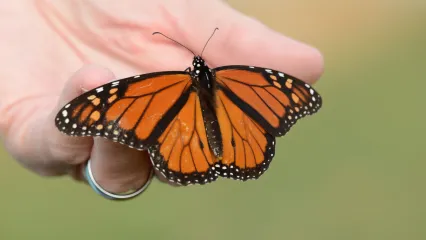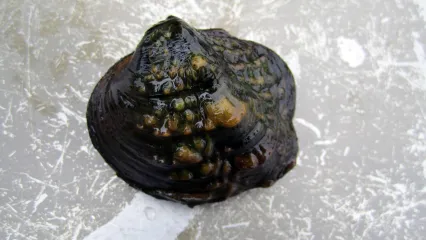
Description
With striking orange and black wings, the monarch (Danaus plexippus) is perhaps one of the most recognized of North American butterflies. Thin, black veins intersect the orange wings and lead to thick marginal borders peppered with white spots. Males can be identified by the black scent patches located on the hindwings.
Size
Monarchs are fairly large butterflies and measure 3.5 to 4 inches in length.
Habitat
Milkweed plants are especially important for caterpillars, but adult butterflies feed on nectar from flowering plants like goldenrod, asters and gayfeather. Two distinct populations of monarchs can be found in the United States. The western migratory population breeds in the western United States and Canada and winters near the California coast. Monarchs found in Oklahoma belong to the eastern migratory population. This population breeds in the central and eastern United States and southern Canada and winters in Mexico. Some butterflies in the eastern population migrate over 2,000 miles! The monarch is the only butterfly to make such a long two-way migration.
Life Cycle
Monarchs undergo complete metamorphosis. Development from an egg to an adult typically takes one month. After mating in the spring and summer, the female monarch lays one egg on the underside of a milkweed leaf. (She can lay up to 300 eggs in her short life span!) Three to four days later, the egg hatches into a caterpillar. These caterpillars feed exclusively on the milkweed plant for about two weeks. To compensate for their growing body, caterpillars shed their skin five times during this stage. After two weeks, the caterpillar forms a hardened, green pupa. One to two weeks later, an adult butterfly emerges from the pupa and begins the next generation. The incredible journey from Mexico to Canada and back may only take one year, but requires four generations of monarchs. The first three generations are relatively short-lived and are focused on creating the next generation. During one month’s time, the adult butterflies must travel north, find a mate and lay eggs on milkweed plants. The fourth and final generation of the year hatches in the northern United States or southern Canada and is focused on migration. These fourth generation butterflies travel more than 600 miles south to traditional monarch wintering grounds in Mexico. It is believed the migratory behavior of this final generation is triggered by environmental cues like decreasing day length and evening temperatures. After arriving in Mexico, monarchs form dense clusters, or colonies, on tree branches and trunks. Individual colonies can cover 1 to 12 acres of forest!


